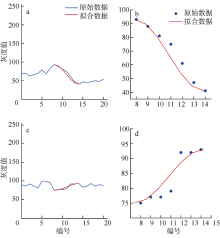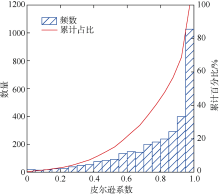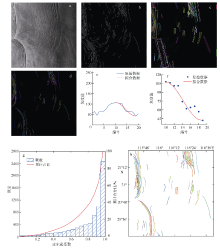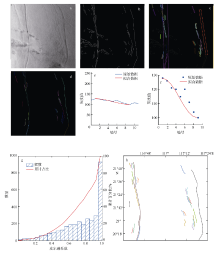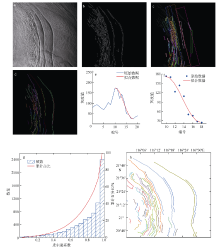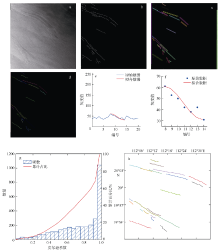Journal of Tropical Oceanography ›› 2020, Vol. 39 ›› Issue (6): 41-56.doi: 10.11978/2019120CSTR: 32234.14.2019120
• Marine Hydrology • Previous Articles Next Articles
Detection algorithm of internal waves in the South China Sea based on boundary characteristics of remote sensing image
ZHENG Yinggang( ), ZHANG Hongsheng(
), ZHANG Hongsheng( ), LI Xiaolian, ZHANG Zhouhao
), LI Xiaolian, ZHANG Zhouhao
- College of Ocean Science and Engineering, Shanghai Maritime University, Shanghai 201306, China
-
Received:2019-11-23Revised:2020-01-22Online:2020-10-10Published:2020-04-09 -
Contact:ZHANG Hongsheng E-mail:ingopro@qq.com;hszhang@shmtu.edu.cn -
Supported by:National Natural Science Foundation of China(51679132);National Natural Science Foundation of China(51079082);Capacity Construction Project of Local University Base of Shanghai Science and Technology Commission(17040501600)
CLC Number:
- P731.24
Cite this article
ZHENG Yinggang, ZHANG Hongsheng, LI Xiaolian, ZHANG Zhouhao. Detection algorithm of internal waves in the South China Sea based on boundary characteristics of remote sensing image[J].Journal of Tropical Oceanography, 2020, 39(6): 41-56.
share this article
Add to citation manager EndNote|Reference Manager|ProCite|BibTeX|RefWorks
Tab. 5
Information of SAR ocean images"
| 样本 | 像素 | 发生时间 | 中心经纬度 | 经纬度范围 |
|---|---|---|---|---|
| A | 8415×9558 | 2005-05-09, 02:16 | 21°45′N, 116°28′E | 21°06′—22°18′N, 115°52′—117°05′E |
| B | 7913×8647 | 2002-06-24, 02:45 | 20°57′N, 116°13′E | 20°21′—21°26′N, 115°40′—116°47′E |
| C | 8395×9813 | 2007-09-12, 02:13 | 21°16′N, 117°06′E | 20°37′—21°54′N, 116°29′—117°28′E |
| D | 4899×6121 | 2005-08-22, 02:45 | 21°21′N, 116°18′E | 20°43′—21°59′N, 115°45′—116°55′E |
| E | 6649×9830 | 2009-06-12, 02:31 | 20°28′N, 112°30′E | 19°51′—20°05′N, 112°01′—113°01′E |
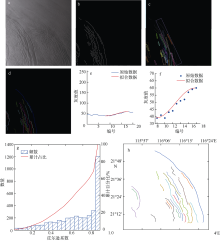
Fig. 18
Recognition of stripes in internal wave A. a) column separation neighborhood processing; b) Canny processing; C) stripe detection; d) stripe recognition; e) fitting of light and dark stripes; f) extraction of light and dark stripes; g) distribution of Pearson correlation coefficient; and h) extraction of longitude and latitude of each stripe"

| [1] | 曹锦涛, 2017. 星载合成孔径雷达对海内波检测与参数估计[D]. 哈尔滨: 哈尔滨工业大学. |
| CAO JINGTAO, 2017. Detection and parameter estimation of internal wave by space-borne SAR[D]. Haerbin: Harbin Institute of Technology (in Chinese with English abstract). | |
| [2] | 陈捷, 陈标, 许素芹, 2009. 一种新的SAR图像内波检测与参数估计方法[J]. 中国图象图形学报, 14(1):40-44. |
| CHEN JIE, CHEN BIAO, XU SUQIN, 2009. A novel method on internal wave detection and parameter estimation from SAR images[J]. Journal of Image and Graphics, 14(1):40-44 (in Chinese with English abstract). | |
| [3] | 陈捷, 陈标, 许素芹, 2010. 基于二维连续小波变换的SAR图像海洋现象特征检测[J]. 电子学报, 38(9):2128-2133. |
| CHEN JIE, CHEN BIAO, XU SUQIN, 2010. Detection of ocean features in SAR images with 2D continuous wavelet power spectrum[J]. Acta Electronica Sinica, 38(9):2128-2133 (in Chinese with English abstract). | |
| [4] | 陈捷, 陈标, 陶荣华, 等, 2014. SAR图像海洋内波参数自动提取方法[J]. 海洋技术学报, 33(6):20-27. |
| CHEN JIE, CHEN BIAO, TAO RONGHUA, et al, 2014. An automatic extraction method of SAR images of ocean internal wave parameters[J]. Journal of Ocean Technology, 33(6):20-27 (in Chinese with English abstract). | |
| [5] | 丁灿, 张本涛, 高国兴, 等, 2012. 合成孔径雷达图像中海洋内波的特征检测[J]. 海洋测绘, 32(5):15-18. |
| DING CAN, ZHANG BENTAO, GAO GUOXING, et al, 2012. Feature detection of ocean internal wave in SAR image[J]. Hydrographic Surveying and Charting, 32(5):15-18 (in Chinese with English abstract). | |
| [6] | 段锁林, 殷聪聪, 李大伟, 2018. 改进的自适应Canny边缘检测算法[J]. 计算机工程与设计, 39(6):1645-1652. |
| DUAN SUOLIN, YIN CONGCONG, LI DAWEI, 2018. Improved adaptive Canny edge detection algorithm[J]. Computer Engineering and Design, 39(6):1645-1652 (in Chinese with English abstract). | |
| [7] | 范开国, 黄韦艮, 甘锡林, 等, 2010. SAR海洋内波表层流反演方法探讨[J]. 遥感学报, 14(1):122-130. |
| FAN KAIGUO, HUANG WEIGEN, GAN XILIN, et al, 2010. Retrieving internal wave surface currents from SAR image[J]. Journal of Remote Sensing, 14(1):122-130 (in Chinese with English abstract). | |
| [8] | 范开国, 周晓中, 徐青 , 等, 2017. 合成孔径雷达海洋内波遥感探测技术与应用[M]. 北京: 海洋出版社: 2-3. |
| [9] | 甘锡林, 黄韦艮, 杨劲松, 等, 2007. 基于希尔伯特-黄变换的合成孔径雷达内波参数提取新方法[J]. 遥感学报, 11(1):39-47. |
| GAN XILIN, HUANG WEIGEN, YANG JINSONG, et al, 2007. A new method to extract internal wave parameters from SAR imagery with Hilbert-Huang transfrom[J]. Journal of Remote Sensing, 11(1):39-47 (in Chinese with English abstract). | |
| [10] | 郎丰铠, 杨杰, 李德仁, 2014. 极化SAR图像自适应增强Lee滤波算法[J]. 测绘学报, 43(7):690-697. |
| LANG FENGKAI, YANG JIE, LI DEREN, 2014. An adaptive enhanced Lee speckle filter for polarimetric SAR image[J]. Acta Geodaetica et Cartographica Sinica, 43(7):690-697. | |
| [11] | 李海艳, 杜涛, 2005. 两层模式下内波K-dv方程的频散关系[J]. 水动力学研究与进展, 20(5):673-679. |
| LI HAIYAN, DU TAO, 2005. Dispersive relation of internal solitary waves of the two layers model K-dv function[J]. Journal of Hydrodynamics, 20(5):673-679 (in Chinese with English abstract). | |
| [12] | 李海艳, 何宜军, 杜涛, 等, 2007. 从内波SAR图像中提取跃层深度和内波振幅的非线性方法[J]. 海洋环境科学, 26(6):583-586, 590. |
| LI HAIYAN, HE YIJUN, DU TAO, et al, 2007. Nonlinear method of extracting thermocline depth and amplitude of internal wave from SAR imagery[J]. Marine Environmental Science, 26(6):583-586, 590 (in Chinese with English abstract). | |
| [13] | 郦苏丹, 李广侠, 2006. 结合多尺度边缘检测的SAR结构邻域滤波方法[J]. 电子与信息学报, 28(8):1480-1484. |
| LI SUDAN, LI GUANGXIA, 2006. A SAR image filter method based on structured neibourhood model with multi-scale edges detection[J]. Journal of Electronics & Information Technology, 28(8):1480-1484 (in Chinese with English abstract). | |
| [14] | 林珲, 范开国, 申辉, 等, 2010. 星载SAR海洋内波遥感研究进展[J]. 地球物理学进展, 25(3):1081-1091. |
| LIN HUI, FAN KAIGUO, SHEN HUI, et al, 2010. Review on remote sensing of oceanic internal wave by space-borne SAR[J]. Progress in Geophysics, 25(3):1081-1091 (in Chinese with English abstract). | |
| [15] | 刘冰清, 2015. 南海北部内波时空传播特征的遥感研究[D]. 上海: 上海海洋大学. |
| LIU BINGQING, 2015. Internal solitary wave (ISW) propagation characteristics research in the northern South China Sea (SCS) based on multisatellite observations[D]. Shanghai: Shanghai Ocean University (in Chinese with English abstract). | |
| [16] | 刘成龙, 2017. Matlab图像处理[M]. 北京: 清华大学出版社: 189-190. |
| LIU CHENGLONG, 2017. Image processing with MATLAB[M]. Beijing: Tsinghua University Press: 189-190(in Chinese). | |
| [17] | 申辉, 2005. 海洋内波的遥感与数值模拟研究[D]. 青岛: 中国科学院海洋研究所. |
| SHEN HUI, 2005. Remote sensing and numerical modeling of oceanic internal waves [D]. Qingdao: Institute of Oceanology, Chinese Academy of Sciences (in Chinese with English abstract). | |
| [18] | 石爽, 曲仕茹, 何力, 2011. 一种新的边界跟踪算法[J]. 工程图学学报, 32(3):52-56. |
| SHI SHUANG, QU SHIRU, HE LI, 2011. A new algorothm for boundary tracing[J]. Journal of Engineering Graphics, 32(3):52-56 (in Chinese with English abstract). | |
| [19] | 汪雄良, 王春玲, 朱炬波, 等, 2012. 基于EEMD的SAR海洋内波参数反演[J]. 测试技术学报, 26(1):1-8. |
| WANG XIONGLIANG, WANG CHUNLING, ZHU JUBO, et al, 2012. Extracting internal wave parameters from SAR image based on ensemble empirical mode decomposition[J]. Journal of Test and Measurement Technology, 26(1):1-8 (in Chinese with English abstract). | |
| [20] | 张祥, 邓喀中, 范洪冬, 2011. 融合Canny边缘检测技术的SAR图像改进滤波方法[J]. 黑龙江工程学院学报(自然科学版), 25(2):6-9, 38. |
| ZHANG XIANG, DENG KAZHONG, FAN HONGDONG, 2011. Improved SAR image denoising algorithm of fusing Canny edge extraction technology[J]. Journal of Heilongjiang Institute of Technology, 25(2):6-9, 38 (in Chinese with English abstract). | |
| [21] | HOGAN G G, MARSDEN J B, HENRY J C, 1991. On the detection of internal waves in high resolution sar imagery using the hough transform [C]//OCEANS 91 proceedings. Honolulu, HI, USA: IEEE:1363-1369. |
| [22] | RODENAS J A, GARELLO R, 1998a. A new automatic internal wave detection and characterization method for SAR images [C]// IEEE Oceanic Engineering Society. OCEANS’98. Conference Proceedings (Cat. No. 98CH 36259). Nice, France: IEEE:613-618. |
| [23] | RODENAS J A, GARELLO R , 1998b. Internal wave detection and location in SAR images using wavelet transform[J]. IEEE Transactions on Geoscience and Remote Sensing, 36(5):1494-1507. |
| [24] | SHEN HUI, HE YIJUN, 2005. Study internal waves in North West of South China Sea by satellite images [C]//IGARSS. Proceedings of 2005 IEEE International Geoscience and Remote Sensing Symposium. Seoul, South Korea: IEEE:2539-2542. |
| [25] | SMALL J, HALLOCK Z, PAVEY G , et al, 1999. Observations of large amplitude internal waves at the Malin Shelf edge during SESAME 1995[J]. Continental Shelf Research, 19(11):1389-1436. |
| [26] | SUTHERLAND B R, LINDEN P F , 2002. Internal wave excitation by a vertically oscillating elliptical cylinder[J]. Physics of Fluids, 14(2):721-731. |
| [27] | VORONOVICH A G , 2003. Strong solitary internal waves in a 2.5-layer model[J]. Journal of Fluid Mechanics, 474:85-94. |
| [1] | GUO Jianlin, SUN Xian, YANG Yufeng, WANG Qing. The succession characteristics of copepod community structure in the seaweed bed and its adjacent waters in the Weizhou Island, Guangxi Province [J]. Journal of Tropical Oceanography, 2023, 42(4): 155-165. |
| [2] | ZHENG Guobin, ZHAO Hongbo, HUANG Liangmin, ZHANG Jing, LIU Xiande. Discovery and verification of SNP in Acanthopagrus latus [J]. Journal of Tropical Oceanography, 2023, 42(2): 78-86. |
| [3] | ZHANG Chengfei, REN Guangbo, WU Peiqiang, HU Yabin, MA Yi, YAN Yu, ZHANG Jingrui. Mangrove species classification in the Hainan Bamen Bay based on GF optics and fully polarimetric SAR [J]. Journal of Tropical Oceanography, 2023, 42(2): 153-168. |
| [4] | LIU Shuang, JING Zhiyou, ZHAN Haigang. Predicting the mesoscale eddy in the tropical and subtropical ocean based on generative adversarial network model [J]. Journal of Tropical Oceanography, 2022, 41(5): 1-16. |
| [5] | LIU Lijie, LIN Lidong. The effect of high temperature on stress physiology of Sargassum fusiforme [J]. Journal of Tropical Oceanography, 2021, 40(2): 74-82. |
| [6] | Yubin JI,Zhe ZHANG,Weihao ZHANG,Hu WANG,Ying PAN,Wei JIANG. QSI activity-oriented isolation of metabolites from Fusarium solanum [J]. Journal of Tropical Oceanography, 2019, 38(3): 98-103. |
| [7] | WANG Jian, DU Yan, ZHENG Shao-jun, LIU Kai. Interannual variability of Indonesian throughflow in the Makassar Strait during 2004~2011 [J]. Journal of Tropical Oceanography, 2014, 33(6): 9-16. |
| [8] | LI Jian-peng, ZHAO Su-fen, SUN Hui-qiang, LIU Dong-chao, LI Hai-juan, LI Guo-rong. Effects of salinity on egg release and early development of Sargassum cinereum (Fucales, Phaeophyta) germlings [J]. Journal of Tropical Oceanography, 2014, 33(1): 97-104. |
|
||
































